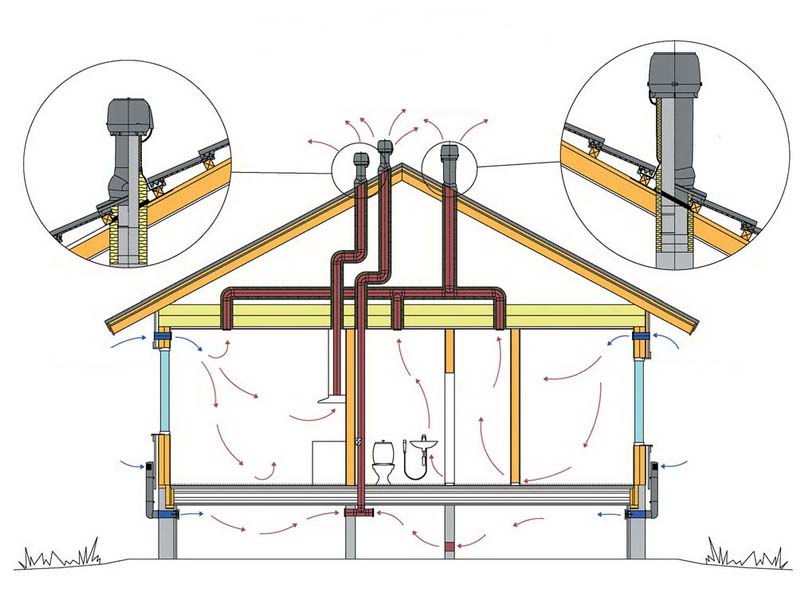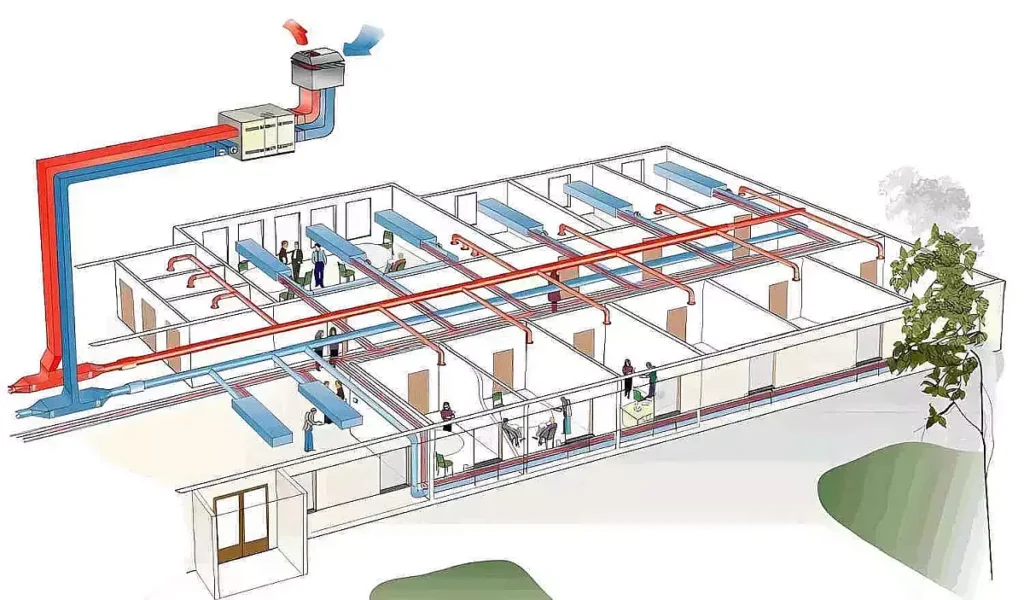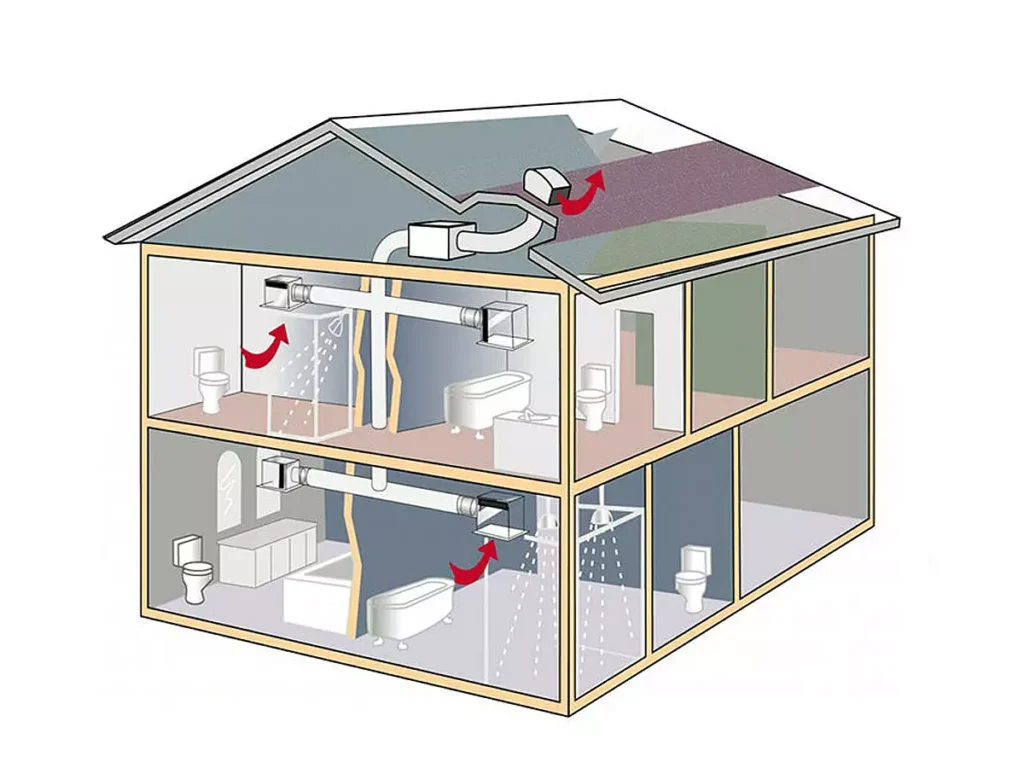Types of ventilation
Ventilation of premises is a set of technical means and devices designed to ensure air exchange in premises, maintain optimal microclimate parameters, remove pollutants and excess moisture, and create comfortable living and working conditions. There are three main types of ventilation: natural, mechanical, and combined.
Natural ventilation
Relies on natural forces (wind, temperature differences). It utilizes open windows and ventilation ducts. Examples include cross-ventilation and transom windows.
All multi-story residential buildings are equipped with vertical air collector systems that draw air from bathrooms, toilets, and kitchens. Air moves through exhaust air ducts due to the temperature difference between outside air and indoor air, as well as the difference in gravitational and wind pressure. Air is drawn in through vacuum from exhaust systems, through leaks in walls, windows, doors, or simply through ventilation. This is called air infiltration and requires an increase in heating system capacity to heat the drawn-in outside air during the winter.

Benefits of natural ventilation
- Do not consume electricity, as they operate without fans or associated equipment;
- Energy-independent;
- Do not create noise;
- There is no need to purchase expensive ventilation equipment, lay pipelines for the heating system, or install automation panels;
- Do not require large maintenance and installation costs.
Disadvantages of natural ventilation
- The operation of natural ventilation systems is directly dependent on external factors;
- In summer, their efficiency is minimal;
- They require the installation of ventilation ducts at the design and initial construction stages, as it is impossible to install natural ventilation ducts during building renovations;
- It is impossible to install horizontal air ducts;
- Without air flow into the room, natural exhaust systems will not function.
Mechanical ventilation
This is a forced-air ventilation system that uses fans to supply fresh air and remove stale air. It provides controlled airflow and can provide heating, filtration, and air conditioning, creating a comfortable microclimate and maintaining a healthy indoor environment.

Features of the mechanical type
- Forced air movement: Fans create a pressure difference, forcing air through the ducts.
- Air treatment: Before entering the room, the air is filtered to remove dust and particles, and can also be heated, humidified, or ionized.
- Control: Modern systems allow for automation, regulation of air flow speed, and coupling of their operation to temperature, humidity, and even occupancy.
Types of mechanical ventilation
- Supply: Only supplies fresh, treated air.
- Exhaust: Only removes stale air from the room.
- Supply and exhaust: Combines forced supply of fresh air and forced removal of stale air.
Advantages of mechanical ventilation
- Air Quality Control: Mechanical ventilation provides a constant supply of fresh air and removes pollutants, improving indoor air quality.
- Temperature and Humidity Control: Modern systems can maintain optimal temperature and humidity levels, promoting comfortable living and working conditions.
- Energy Efficiency: Some systems are equipped with recuperators, which save energy by recovering heat from exhaust air.
- Automation: Many systems can be integrated with smart homes, allowing for automatic ventilation adjustments based on conditions.
- Safety: In healthcare facilities, mechanical ventilation is essential to prevent the spread of infections and ensure sterility.
Disadvantages of the fan option
- Installation and Maintenance Costs: Installing mechanical ventilation can require significant equipment and installation costs, as well as regular maintenance.
- Noise: Some systems can create noise during operation, which can be uncomfortable for users.
- Energy Costs: While systems may be energy efficient, they still require electricity to operate, which can increase utility bills.
- Requirement for Regular Maintenance: Filters and other components require regular replacement and cleaning to maintain the system’s efficiency.
- Power Dependence: In the event of a power outage, the system stops operating, which can lead to poor air quality.
Combined ventilation
Combination (or mixed) ventilation is a system that combines natural air exchange with mechanical ventilation, such as air intake through window vents and mechanical exhaust using fans, or vice versa.
- Natural Intake/Mechanical Exhaust Scheme:
Intake: Fresh air enters the room through special wall or window vents, which may be automatically controlled to regulate air flow.
Exhaust: Exhaust air is removed from utility rooms (kitchens, bathrooms) using fans installed in exhaust ducts. - Mechanical Intake/Natural Exhaust Scheme
Intake: Fans supply fresh air to the rooms.
Exhaust: Air is naturally exhausted through ventilation ducts.

Advantages of the combined type
- Efficiency: Combines the benefits of natural and mechanical ventilation, ensuring stable air exchange year-round.
- Efficiency: Reduces costs compared to a fully mechanical system by using simpler and less energy-intensive solutions for one function (e.g., air supply).
- Flexibility: Ability to regulate fan operation (e.g., using CO2 sensors) to maintain the required ventilation level and conserve resources.
- Comfort: Provides fresh air and removes harmful substances, moisture, and odors from rooms.
The goal of this solution is to achieve optimal air quality by leveraging the advantages of both systems to ensure a comfortable and healthy indoor climate at minimal cost.
